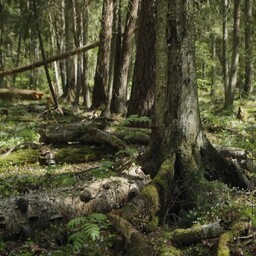Eelmisel nädalal ütles minister Andres Sutt, et ministeerium otsustab metsade soostamise plaaniga edasi minna. Ta rääkis, et nad arutasid ka Maaülikooliga. Kuid Maaülikool ütles, et nad pole minister Sutiga metsade veerežiimi muutmise teemal rääkinud. Marek Metslaid, Maaülikooli metsaökoloogia professor, ütles, et nad on nõus oma
teadmisi jagama
, kuid pole sellest teemast rääkinud.
teadmisi jagama
Tõlge fraasile: teadmisi jagama
EN
share knowledge
Metslaid arvab, et plaanid soode ja märgade metsade taastamiseks vajavad veel kord üle vaatamist. Ta ütles, et
metsade soostamine
muudab ökosüsteemi väga palju. Väiksemas mahus on Eestis kraave kinni pandud ja seal on võimalik märgalade taastumist näha, kuid pikaajalist mõju ei tea keegi.
metsade soostamine
Tõlge fraasile: metsade soostamine
EN
rewetting of forests
Professor ütles, et on oluline mõelda, kas nii palju töid on vaja teha. Kui
pikaajalised negatiivsed mõjud
ilmnevad, on keeruline ja kallis protsessi tagasi keerata. Ta lisas, et kiirustada ei tohi, sest sellised muudatused vajavad kohalike inimeste kaasamist.
pikaajalised negatiivsed mõjud
Tõlge fraasile: pikaajalised negatiivsed mõjud
EN
long-term negative effects
Metslaid rõhutas, et metsade soostamisel on ka
sotsiaalmajanduslikud tagajärjed
. Lisaks on soometsades suur
süsinikuvaru
ning
veetaseme tõstmine
võib seda kahjustada. Ta ütles, et vahepeal on vaja pausi teha ja enne lõplikke otsuseid veel uurida.
sotsiaalmajanduslikud tagajärjed
Tõlge fraasile: sotsiaalmajanduslikud tagajärjed
EN
socio-economic consequences
süsinikuvaru
Tõlge fraasile: süsinikuvaru
EN
carbon stock
veetaseme tõstmine
Tõlge fraasile: veetaseme tõstmine
EN
raising the water level
Praegu on Eestis taastatud üle 23 000 hektari soid ja soometsi. Kliimaministeeriumi andmetel on Eestis kuivendatud ligi 750 000 hektarit metsamaad. Veerežiimi taastamistöid on tehtud 0,5 protsendil ja kavas on taastada veel 1,5 protsendil metsamaast.
Last week, Minister Andres Sutt said that the ministry has decided to proceed with the forest paludification plan. He mentioned that they had also discussed it with the University of Life Sciences. However, the University of Life Sciences stated that they had not spoken with Minister Sutt about changing the water regime of forests. Marek Metslaid, a professor of forest ecology at the University of Life Sciences, said that they are willing to share their knowledge but have not discussed this topic.
Metslaid believes that plans for the restoration of bogs and wet forests need to be reviewed again. He said that forest paludification changes the ecosystem significantly. In smaller volumes, ditches have been closed in Estonia, and it is possible to see the restoration of wetlands there, but no one knows the long-term effects.
The professor said that it is important to consider whether so much work needs to be done. If long-term negative effects appear, it will be difficult and expensive to reverse the process. He added that there should be no rush, as such changes require the involvement of local people.
Metslaid emphasized that forest paludification also has socio-economic consequences. In addition, bog forests have a large carbon reserve, and raising the water level could damage it. He said that in the meantime, a pause is needed, and more research is required before final decisions are made.
Currently, over 23,000 hectares of bogs and bog forests have been restored in Estonia. According to the Ministry of Climate, nearly 750,000 hectares of forest land have been drained in Estonia. Water regime restoration work has been carried out on 0.5 percent, and plans are in place to restore another 1.5 percent of forest land.

